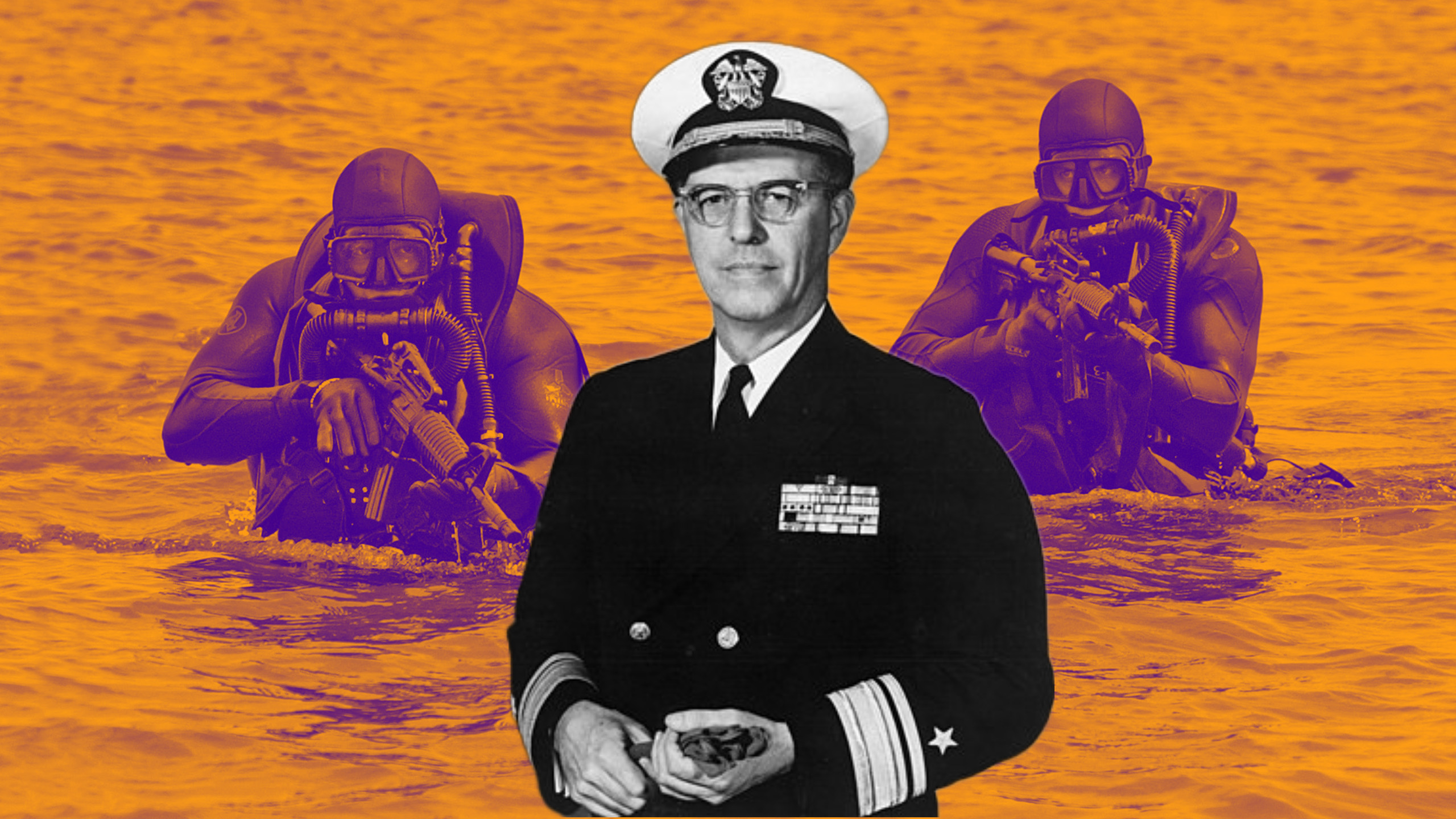The first military Navy SEAL, or Sea, Air, and Land teams, can be traced back to the establishment of the Underwater Demolition Teams (UDTs) during World War II. The UDTs were responsible for conducting underwater reconnaissance, demolitions, and other specialized operations in support of amphibious landings. These brave and highly skilled teams played a crucial role in the success of amphibious operations, utilizing their expertise in underwater reconnaissance, demolitions, and obstacle clearing. While often overshadowed by other prominent units, the UDTs were the unsung heroes of amphibious warfare, undertaking perilous missions to ensure the success of key Allied operations.
One of the key figures associated with the origins of the Navy SEALs is Rear Admiral Draper Laurence Kauffman (4 August 1911 – 18 August 1979). In 1943, Kauffman developed the concept of the UDTs and played a crucial role in their formation. He envisioned a group of highly skilled individuals capable of conducting covert operations both on land and in the water. His wartime service also included participation in the invasions of Saipan, Tinian, Iwo Jima, and Okinawa.
He was an American underwater demolition expert, who served during the 1960s as 44th Superintendent of the United States Naval Academy. During World War II, he organized the first U.S. Navy Combat Demolition Units from which the SEALs and Navy Explosive Ordnance Disposal (EOD) would evolve. On March 15, 1943, the first UDT unit, known as UDT-1, was commissioned. It consisted of seven officers and 34 enlisted men, handpicked from volunteers across the Navy. Under the command of Lieutenant Draper Kauffman, UDT-1 underwent intensive training in demolitions, swimming, diving, small boat handling, and other specialized skills. During World War II, UDT-1 and subsequent UDT units participated in numerous operations in the Pacific Theater. They played a critical role in clearing obstacles, conducting beach reconnaissance, and providing support during amphibious assaults. Their expertise in underwater demolitions proved invaluable in securing strategic locations for Allied forces.
After the war, the UDTs continued to evolve and adapt to new challenges. In 1961, President John F. Kennedy recognized the need for a maritime special operations force and established the Navy SEALs. The UDTs became an integral part of this new organization, and their skills and experience formed the foundation of the SEAL teams. The Navy SEALs went on to become one of the most elite and highly respected special operations forces in the world. They have been involved in a wide range of missions, including counterterrorism operations, hostage rescues, reconnaissance, and direct action raids. SEAL teams have served in conflicts and operations around the globe, including the War in Afghanistan, the Iraq War, and counter-piracy operations off the coast of Somalia.
The first military Navy SEALs laid the groundwork for what would become a storied and revered special operations force. Their courage, skills, and dedication set the standard for future generations of SEALs. The Navy SEALs continue to carry on their legacy, upholding the highest standards of excellence in service to their country. The Oliver Hazard Perry-class frigate Kauffman (FFG-59), launched in 1987, was named in honor of Draper Kauffman and his father, Vice Admiral James L. Kauffman (1887–1963). His roles as the founder of U.S. Naval Bomb Disposal and as the creator of hell week for the UDT/SEALs were honored with the creation of the Kauffman EOD Training Complex at Eglin AFB, Florida, and the Draper L. Kauffman Naval Special Warfare Operations Facility in Norfolk, Virginia. His great-niece named her first-born child after her great uncle. Professor Kelsey Kauffman, of DePauw University, is his daughter and is an author. Taren Stinebrickner-Kauffman, founder of SumOfUs, is a granddaughter.
A few famous members of the UDTs:
- Lieutenant Commander Draper L. Kauffman: As the visionary behind the UDTs, Lieutenant Commander Draper L. Kauffman was instrumental in their creation. He championed the concept of specialized underwater teams and led UDT-1, the first UDT unit. Kauffman’s leadership, innovation, and dedication to excellence set the standard for the UDTs and established a legacy that continues to shape the Navy SEALs.
- Lieutenant Lloyd E. “Pete” Stark: Lieutenant Lloyd E. Stark, a UDT-4 officer, made significant contributions to the success of the UDTs during World War II. He played a pivotal role in the planning and execution of numerous amphibious landings, including the D-Day invasion of Normandy. Stark’s expertise in underwater reconnaissance and demolition ensured the safety of Allied troops and expedited the establishment of beachheads.
- Lieutenant William B. “Bill” Allen: Lieutenant William B. Allen, a member of UDT-5, demonstrated exceptional leadership and bravery throughout his service. He participated in the Pacific island-hopping campaign, conducting reconnaissance missions and clearing obstacles to secure critical landing zones. Allen’s courage under fire and unwavering commitment to mission success earned him the Navy Cross, one of the highest military honors.
- Lieutenant John D. “Jack” Taylor: Lieutenant John D. Taylor, a member of UDT-10, became renowned for his extraordinary exploits during World War II. He participated in the liberation of the Philippines, where his UDT team conducted daring night raids, clearing obstacles and demolishing enemy fortifications. Taylor’s exceptional leadership and combat skills earned him the Medal of Honor, the highest award for valor in the U.S. military.
- Lieutenant Junior Grade John D. “Bullfrog” Roach: Lieutenant Junior Grade John D. Roach, a member of UDT-11, distinguished himself through his exceptional physical prowess and fearlessness. Roach was known for his remarkable ability to swim long distances underwater, often completing missions that seemed impossible to others. His unparalleled determination and unmatched swimming skills made him a legendary figure within the UDT community.

